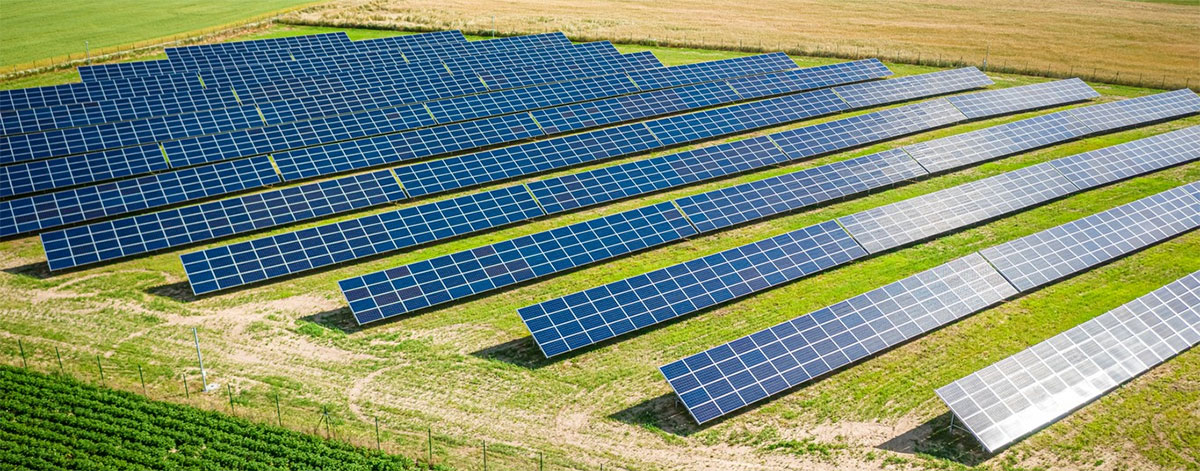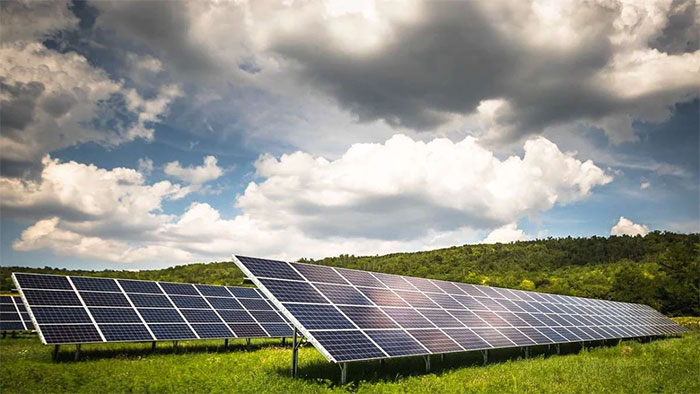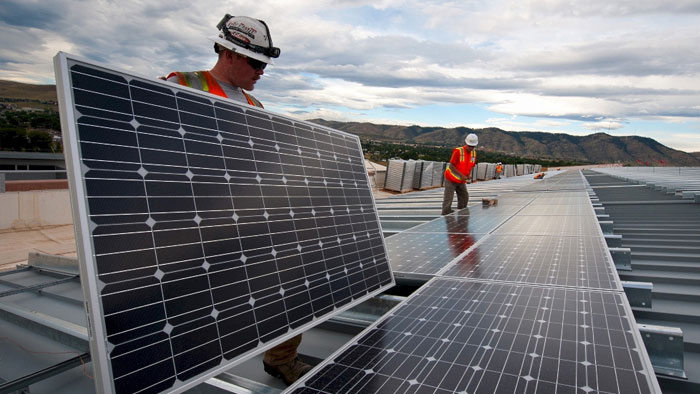
Solar farms play a vital role in expanding renewable energy capacity, reducing greenhouse gas emissions, and transitioning to a more sustainable energy future. In this post we argue about solar farm construction.
What is a solar farm?
A solar farm, also known as a solar power plant or solar park, is a large-scale installation of solar panels designed to capture sunlight and convert it into electricity. These solar panels, also called photovoltaic (PV) panels, are typically mounted on racks or frames and arranged in rows over a vast area of land.
The primary purpose of a solar farm is to generate renewable energy on a commercial scale. The electricity generated by the solar panels can be fed into the electrical grid to provide power to homes, businesses, and industries. Solar farms are often situated in areas with high levels of sunlight exposure to maximize energy production.
Solar farms can vary in size, ranging from a few acres to hundreds or even thousands of acres, depending on factors such as available land, sunlight intensity, and the desired electricity output. They play a crucial role in reducing greenhouse gas emissions and dependence on fossil fuels by harnessing clean and abundant solar energy resources.
Next, we will talk about the solar farm construction.
How does a solar farm work?
A solar farm works by harnessing the energy from sunlight and converting it into electricity through the use of solar panels. Here’s a simplified explanation of how it works:
- Solar Panels: Solar panels, also known as photovoltaic (PV) panels, are made up of multiple solar cells, typically made of silicon. When sunlight strikes these cells, they generate an electric current through the photovoltaic effect.
- Inverter: The electric current generated by the solar panels is direct current (DC), but most electrical grids and appliances use alternating current (AC). Therefore, the DC electricity from the solar panels is fed into an inverter, which converts it into AC electricity suitable for use.
- Grid Connection: The AC electricity produced by the inverter is then connected to the electrical grid. This allows the electricity generated by the solar farm to be distributed to homes, businesses, and industries through the existing power infrastructure.
- Net Metering or Feed-in Tariffs (optional): In many places, solar farm owners can take advantage of net metering or feed-in tariffs. Net metering allows excess electricity generated by the solar farm to be fed back into the grid, and the solar farm owner receives credits or payment for the electricity supplied. Feed-in tariffs provide a guaranteed payment for electricity generated by renewable sources like solar.
- Monitoring and Maintenance: Solar farms require regular monitoring and maintenance to ensure optimal performance. This includes cleaning the solar panels to remove dirt and debris, checking for any damage or malfunctions, and adjusting the positioning of the panels to maximize sunlight exposure.
How much is the cost of a solar farm?
The cost of a solar farm can vary depending on several factors, but here’s a general breakdown:
Per watt:
- The typical cost of building a solar farm is between $0.89 and $1.01 per watt.
- This means a 1MW (megawatt) solar farm would cost somewhere between $890,000 and $1.01 million.
Per acre:
- On an acreage basis, solar farms typically range from $300,000 to $500,000 per acre.
Additional factors affecting cost:
- Size of the farm: Larger farms generally have economies of scale, making them cheaper per watt than smaller ones.
- Type of solar panels: Different panel types have different costs and efficiencies.
- Location: Factors like labor costs, permitting requirements, and land prices can vary by location.
- Land acquisition: Whether you already own the land or need to lease it will impact the total cost.
- Other equipment: Inverters, transformers, batteries, and wiring contribute to the overall cost.
Remember:
- These figures don’t include the cost of land.
- The prices mentioned are averages and can vary depending on the specific project.
How much energy can a solar farm produce?
The amount of energy a solar farm can produce depends on several factors, including its size, location, orientation, efficiency of the solar panels, weather conditions, and the amount of sunlight received. Here are some key factors that influence the energy production of a solar farm:
- Size of the Solar Farm: Larger solar farms with more solar panels will generally produce more energy than smaller ones.
- Location: Solar farms located in regions with higher levels of sunlight exposure will produce more energy. Areas closer to the equator typically receive more sunlight throughout the year.
- Orientation and Tilt: The orientation and tilt angle of the solar panels can impact energy production. Panels facing south and tilted at an angle equal to the latitude of the location generally capture the most sunlight.
- Efficiency of Solar Panels: The efficiency of solar panels, which determines how effectively they convert sunlight into electricity, can vary. Higher efficiency panels will produce more energy for a given area of land.
- Weather Conditions: Cloud cover, humidity, and other weather conditions can affect the amount of sunlight reaching the solar panels and thus impact energy production.
- Seasonal Variations: Energy production from solar farms can vary throughout the year due to changes in the angle of the sun and seasonal weather patterns.
What problems are involved in solar farm construction projects?
Solar farm construction process can face several challenges, including:
- Site Selection and Land Acquisition: Identifying suitable locations for solar farms can be challenging due to factors such as land availability, land use regulations, environmental considerations, and proximity to existing electrical infrastructure. Acquiring the necessary land rights and permits can also be time-consuming and costly.
- Permitting and Regulatory Compliance: Solar farm developers must navigate a complex web of regulations and obtain various permits and approvals from local, state, and federal authorities. This process can be lengthy and may involve environmental impact assessments, zoning approvals, land use permits, and interconnection agreements.
- Grid Connection: Connecting a solar farm to the electrical grid requires coordination with utility companies and compliance with technical standards and grid interconnection requirements. Upgrading existing infrastructure or building new transmission lines may be necessary, which can involve additional costs and delays.
- Engineering and Design Challenges: Designing and engineering a solar farm involves considerations such as optimizing the layout of solar panels for maximum energy production, designing support structures to withstand environmental conditions, and integrating electrical systems for power distribution and grid connection.
- Supply Chain and Equipment Availability: Solar farm construction requires a range of equipment and materials, including solar panels, inverters, mounting systems, and electrical components. Delays or disruptions in the supply chain, as well as fluctuations in the availability and cost of materials, can impact project timelines and budgets.
- Construction Risks and Logistics: Construction projects are inherently complex and can face risks such as cost overruns, schedule delays, labor shortages, weather disruptions, and unforeseen technical challenges. Effective project management and logistics planning are essential to mitigate these risks and ensure timely completion.
- Environmental and Community Concerns: Solar farm projects can generate environmental and community concerns related to issues such as habitat disruption, visual impact, land use conflicts, noise, and potential effects on property values. Engaging with stakeholders, addressing concerns, and implementing mitigation measures are important aspects of project development.
What is the largest solar farm in the world?
As of today, the largest solar farm in the world is the Bhadla Solar Park, located in the Thar Desert of Rajasthan, India. It holds the title with an impressive installed capacity of 2,245 megawatts (MW), capable of powering over 1.3 million homes!
Here are some key points about Bhadla Solar Park:
- Location: Rajasthan, India
- Size: Covers an area of 56 sq km
- Capacity: 2,245 MW
- Cost: Approximately $2.2 billion
- Construction: Developed in phases between 2015 and 2019
It’s worth noting that the title of “largest solar farm” can change as new projects come online and expand. Some sources might mention the Huanghe Hydropower Hainan Solar Park in China as the top contender with a similar capacity of 2,200 MW. However, due to its multi-site structure, Bhadla maintains the official title for the largest single-site solar farm.
Using geogrids in solar farm construction
Geogrids are a type of geosynthetic products commonly used in civil engineering and construction projects to improve soil stability, reinforce foundations, and prevent erosion. While geogrids are not typically used directly in the construction of solar farms, they can play a role in addressing certain challenges associated with solar farm development. Here’s how geogrids could be utilized in the construction of solar farms:
- Foundation Stability: Solar panels require stable foundations to support their weight and withstand environmental loads such as wind and snow. Geogrids can be used to reinforce soil beneath foundation structures, such as concrete footings or ballast systems, to improve their stability and load-bearing capacity. This can be particularly beneficial in areas with poor soil conditions or where soil erosion is a concern.
- Slope Stability: Solar farms may be constructed on sloped terrain, which can present challenges related to soil erosion and slope stability. Geogrids can be employed to reinforce slopes and prevent soil erosion, reducing the risk of landslides and ensuring the long-term stability of the site.
- Access Roads and Infrastructure: Solar farm construction requires access roads for equipment transport, installation, and maintenance activities. Geogrids can be used to reinforce roadbeds and prevent rutting, potholes, and erosion, improving the durability and longevity of access roads within the solar farm site.
- Stormwater Management: Stormwater runoff can pose environmental and regulatory challenges during and after construction. Geogrids can be incorporated into stormwater management systems, such as retaining walls, drainage channels, and sediment control measures, to reduce erosion, improve water quality, and comply with regulatory requirements.
- Vegetation Management: Vegetation control is important for maintaining the efficiency and performance of solar panels. Geogrids can be used as a weed barrier beneath ground-mounted solar arrays to prevent weed growth, reduce maintenance requirements, and minimize shading of solar panels.
Conclusion
In conclusion, solar farm construction is a complex process that involves various stages, from site selection and permitting to engineering design, construction, and grid connection. Challenges such as land acquisition, regulatory compliance, grid integration, supply chain management, and environmental considerations must be addressed effectively to ensure successful project execution.







